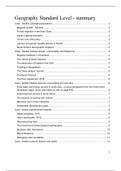Summary
Summary IB Geography Standard Level Case Studies and Definitions
- Course
- Institution
- Book
Summary of Case studies and definitions of terms in the IB geography standard level syllabus (Examinations from May 2019). Includes summary of 4 compulsory units and option A (Leisure, tourism and sport). Case studies summarised to the facts that are really important for remembering to get a high s...
[Show more]




